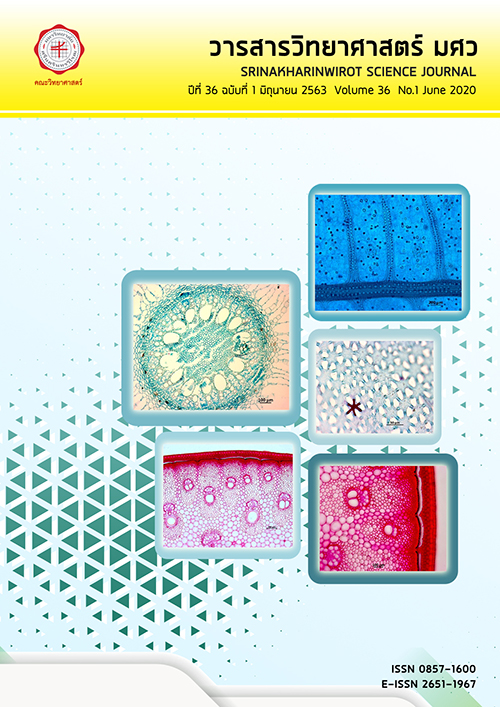In vitro Plant Regeneration from Pseudobulb Segments of Bulbophyllum capillipes C.S.P. Parish & Rchb.f. (Orchidaceae)
Keywords:
สารควบคุมการเจริญเติบโต, กล้วยไม้สิงโตก้านหลอด, การเจริญ, การย้ายปลูก, Plant growth regulators, Bulbophyllum capilipes, Growth, TransplantationAbstract
บทคัดย่อ กล้วยไม้สิงโตก้านหลอด (Bulbophyllum capillipes C.S.P. Parish & Rchb.f.) เป็นกล้วยไม้ที่ปัจจุบันถูกลักลอบนำออกจากป่ามาเพื่อการค้าอย่างต่อเนื่อง จนอาจจะส่งผลให้สถานภาพในอนาคตถูกคุกคามและเสี่ยงต่อการสูญพันธุ์ได้ ดังนั้นการหาวิธีการช่วยขยายพันธุ์ให้ได้เป็นจำนวนมากในเวลาอันรวดเร็วโดยวิธีเพาะเลี้ยงเนื้อเยื่อ จึงเป็นวิธีที่น่าเหมาะสม จากการเลี้ยงส่วนลำต้นเทียมของกล้วยไม้สิงโตก้านหลอดในสภาพปลอดเชื้อบนอาหารสูตรดัดแปลง Vacin and Went (VW, 1949) ที่เติมสารควบคุมการเจริญเติบโตในกลุ่มไซโทไคนิน (Kinetin, BAP, Thidiazuron) หรือออกซิน (IAA, IBA, NAA) ที่แปรผันความเข้มข้น 0 0.5, 1.0, 2.0 และ 4.0 มิลลิกรัมต่อลิตร เพาะเลี้ยงเป็นเวลา 12 สัปดาห์ พบว่า ลำต้นเทียมของสิงโตก้านหลอดที่เลี้ยงบนสูตรอาหาร VW ที่เติม BA 1.0 มิลลิกรัมต่อลิตร ส่งผลให้มีการเจริญเกิดต้นใหม่ (1.2 ต้น) ได้ดีไม่แตกต่างจากชุดควบคุมอย่างมีนัยสำคัญทางสถิติ อีกทั้งการเติม IAA 2.0 มิลลิกรัมต่อลิตร ยังช่วยชักนำให้ลำต้นเทียมเกิดการพัฒนาให้มีรากจำนวนมากและรากมีการยืดยาวออกมาที่สุด และต้นอ่อนสิงโตก้านหลอดมีอัตราการรอดชีวิต 100 เปอร์เซ็นต์ หลังการนำออกปลูกในสแฟกนัมมอสหรือกาบมะพร้าวเมื่อเลี้ยงเป็นระยะเวลา 12 สัปดาห์ ในโรงเรือนเพาะชำ ABSTRACT Bulbophyllum capillipes C.S.P. Parish & Rchb.f. is now smuggled out of the forest for illegal commercialization. This orchid may become threatened and risk of extinction in the near future. Therefore, rapid mass propagation of this species via tissue culture technique will be performed. Pseudobulb segments of Bulbophyllum capillipes C.S.P. Parish & Rchb.f. were in vitro cultured on modified semi-solid Vacin and Went (1949) medium supplemented with different cytokinins; Kinetin (Kn), Benzylaminopurine (BAP), Thidiazuron (TDZ) or auxins; Indole-acetic acid (IAA), Indole-butyric acid (IBA), Naphthalene acetic acid (NAA) at 0, 0.5, 1.0, 2.0 and 4.0 mg.L-1 for 12 weeks. The results showed that the highest average shoot numbers (1.2 shoots) were obtained when they were cultured on the medium augmented with 1.0 mg.L-1 BAP with no significant difference when compared to the control. Moreover, adding 2.0 mg.L-1 of IAA to the medium could induce better root formation number and root elongation from pseudobulb segments than the other. One hundred percent of the plantlets survived during the acclimatization procedure of B. capillipes plantlets could be observed after 12 weeks under greenhouse condition when sphagnum moss and chopped coconut husk were used as planting materials.Downloads
Download data is not yet available.
Downloads
Published
2020-06-26
How to Cite
Wongsa, T., Jacksri, N., & Kongbangkerd, A. (2020). In vitro Plant Regeneration from Pseudobulb Segments of Bulbophyllum capillipes C.S.P. Parish & Rchb.f. (Orchidaceae). Science Essence Journal, 36(1), 107–116. Retrieved from https://ejournals.swu.ac.th/index.php/sej/article/view/11183
Issue
Section
พฤกษศาสตร์แห่งประเทศไทย ครั้งที่ 13(ปิดรับ)








